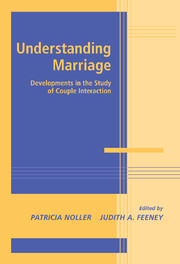Book contents
- Frontmatter
- Contents
- Contribitors
- Introduction
- SECTION ONE THE EFFECT OF COGNITION ON INTERACTION PATTERNS
- SECTION TWO UNDERSTANDING THE IMPORTANCE OF POSITIVE INTERACTION
- SECTION THREE COPING WITH DISAPPOINTMENT, CRITICISM, AND BETRAYAL
- SECTION FOUR POWER, CONFLICT, AND VIOLENCE IN MARITAL INTERACTION
- Marital interaction at important transition periods
- Introduction to Section Five
- 14 Adult Attachment, the Transition to Parenthood, and Marital Well-Being
- 15 Allocation and Performance of Household Tasks: A Comparison of New Parents and Childless Couples
- 16 Care Giving and Its Influence on Marital Interactions between Older Spouses
- SECTION SIX Interventions for strengthening relationships
- Conclusions
- Index
- References
16 - Care Giving and Its Influence on Marital Interactions between Older Spouses
Published online by Cambridge University Press: 25 July 2009
- Frontmatter
- Contents
- Contribitors
- Introduction
- SECTION ONE THE EFFECT OF COGNITION ON INTERACTION PATTERNS
- SECTION TWO UNDERSTANDING THE IMPORTANCE OF POSITIVE INTERACTION
- SECTION THREE COPING WITH DISAPPOINTMENT, CRITICISM, AND BETRAYAL
- SECTION FOUR POWER, CONFLICT, AND VIOLENCE IN MARITAL INTERACTION
- Marital interaction at important transition periods
- Introduction to Section Five
- 14 Adult Attachment, the Transition to Parenthood, and Marital Well-Being
- 15 Allocation and Performance of Household Tasks: A Comparison of New Parents and Childless Couples
- 16 Care Giving and Its Influence on Marital Interactions between Older Spouses
- SECTION SIX Interventions for strengthening relationships
- Conclusions
- Index
- References
Summary
The following is an extract of a conversation between an elderly man and his wife who was caring for him:
Husband: Well I'd like to talk about the showering.
Wife: Oh we've been over that and over.
Husband: Because I have some problems in the night I might be smelly when people come to visit and I'd like to be fresh and clean for the day.
Wife: Poof – been over – over all this.
Husband: I know you want to clean me up before I go to bed but I'd rather you showered me in the morning.
Wife: Oh, let's talk about the garden. What should we plant this year? Do you think the roses need pruning?
Husband: I want to shower in the morning.
Wife: Enough, enough. Laughs Come on, let's talk about our beautiful garden.
Husband: Plant what you like.
Wife: Well how about your favourites, zinnias?
As this extract demonstrates, communication is an important, but sometimes difficult, part of care giving. Family care giving for older people has received much attention in the literature, especially from the perspective of the caregiver. Interestingly, only a limited number of studies have examined the interactional processes of care (for example, Phillips, Morrison, Steffl, Chae, Cromwell, & Russell, 1995). Studies that have examined these issues have shown that, in terms of well-being and quality of relationships, the outcomes of care giving may be just as “negative” for older care recipients as for their carers; further, communication is an important aspect of these relationships.
- Type
- Chapter
- Information
- Understanding MarriageDevelopments in the Study of Couple Interaction, pp. 437 - 462Publisher: Cambridge University PressPrint publication year: 2002



